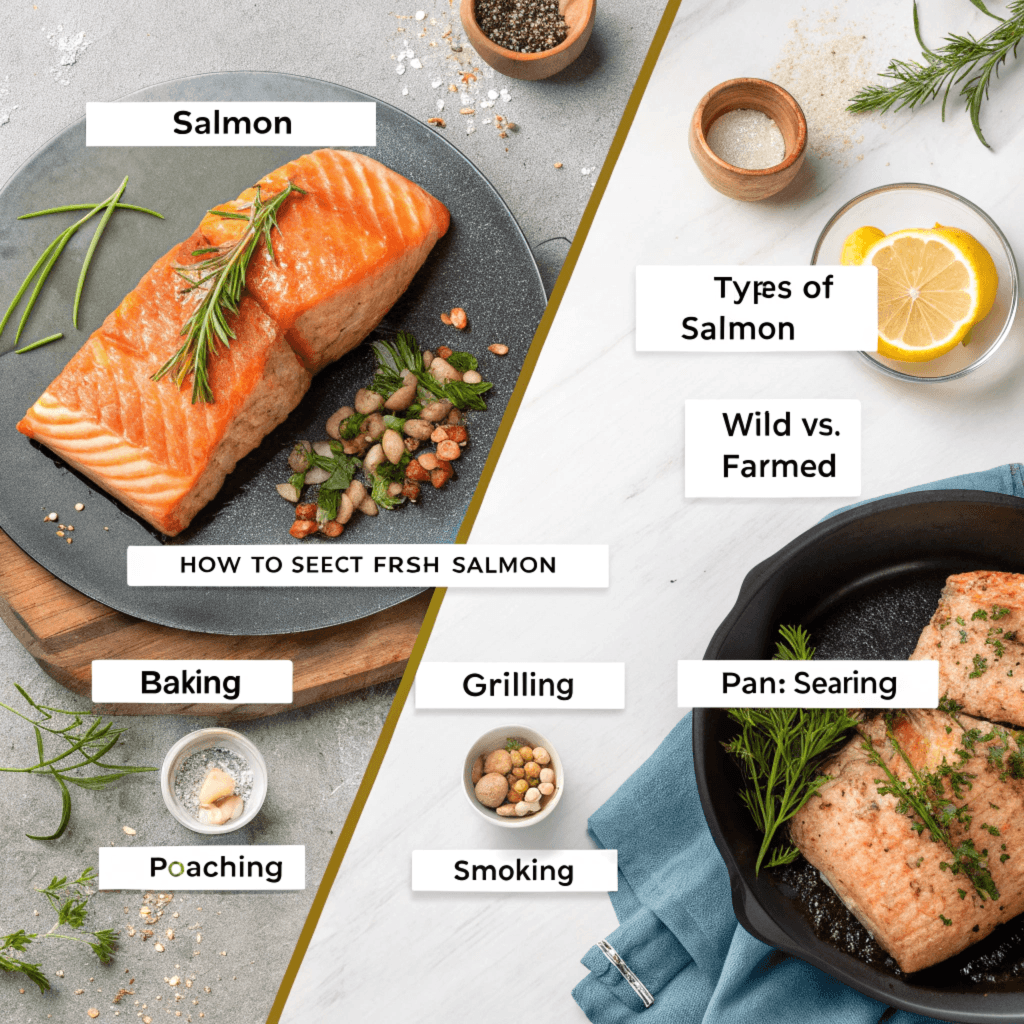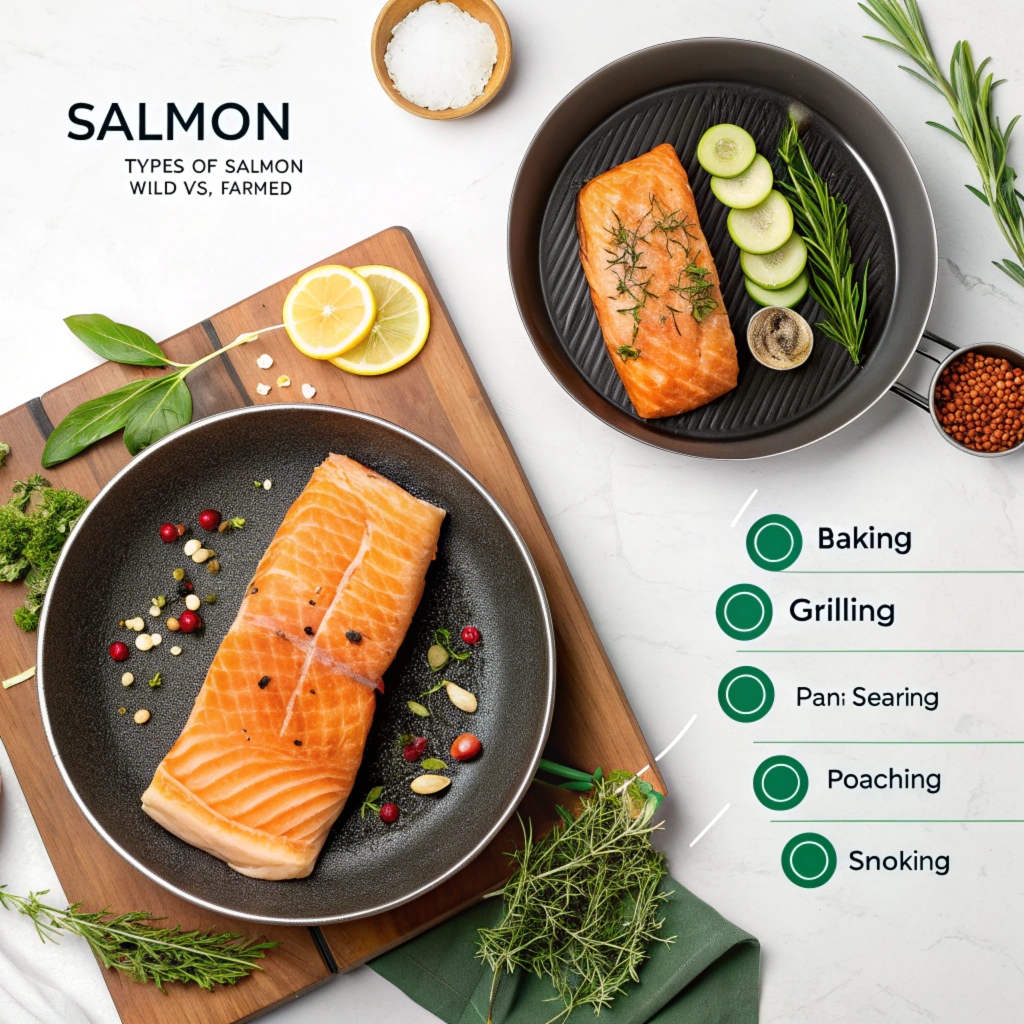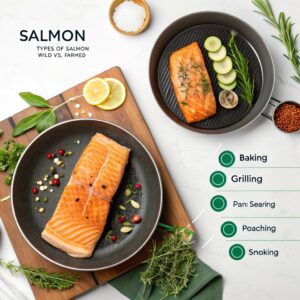
Salmon is a culinary gem celebrated worldwide for its versatility, flavor, and nutritional benefits, making it ideal for exploring the best cooking styles for salmon. Whether you’re a seasoned chef or a home cook experimenting with new recipes, salmon is often the centerpiece of a memorable meal. Its rich, buttery texture and unique taste make it a favorite for a variety of cooking styles, from simple baking to intricate smoking.
But what makes salmon such a standout ingredient? For one, it’s a powerhouse of essential nutrients. Packed with omega-3 fatty acids, high-quality protein, and a variety of vitamins and minerals, salmon is as good for your body as it is for your taste buds. Whether you’re focused on health or flavor—or both—finding the best cooking styles for salmon is an excellent choice.
Renowned chefs like Gordon Ramsay often employ refined techniques to elevate salmon’s natural flavors; learn more about how Gordon Ramsay cooks salmon to inspire your next dish
In this article, we’ll dive into the world of salmon, uncovering the best cooking styles for salmon, tips for preparation, and ways to ensure every bite is perfection. By the end, you’ll have a comprehensive guide to mastering salmon in your kitchen. Let’s explore the possibilities!
Choosing the Right Salmon for Optimal Cooking style
When it comes to preparing salmon, the quality of the fish you choose makes all the difference. Understanding the types of salmon available and knowing how to select the freshest option ensures your dish will be both flavorful and nutritious, no matter which of the best cooking styles for salmon you choose.
Types of Salmon: Wild vs. Farmed
One of the first decisions you’ll face is whether to choose wild-caught or farmed salmon. Both have their characteristics, benefits, and potential drawbacks, which can influence the best cooking styles for salmon.
- Wild Salmon:
- Typically caught in natural habitats like oceans and rivers.
- Known for its robust flavor and leaner texture due to its natural diet and active lifestyle.
- Often considered more sustainable and environmentally friendly, though availability can be seasonal and prices higher.
- Farmed Salmon:
- Raised in controlled environments, making it more widely available and affordable.
- Tends to have a milder flavor and a fattier texture due to its diet.
- While farmed salmon can be a good choice, it’s essential to ensure it comes from reputable sources that prioritize sustainability and minimize environmental impact.
When choosing between the two, consider the flavor profile you prefer, your budget, and your commitment to sustainable practices, as these factors can affect the best cooking styles for salmon you might select.
How to Select Fresh Salmon for the Best Results
No matter which type you choose, freshness is critical for achieving the best results with any of the best cooking styles for salmon. Here’s how to ensure you’re getting high-quality salmon:
- Appearance: Fresh salmon should have vibrant, moist flesh. Avoid fish with dull, discolored spots or excessive liquid in the packaging.
- Smell: A fresh salmon filet should have a clean, ocean-like aroma. A strong, fishy smell is a sign that the fish is past its prime.
- Texture: The flesh should feel firm to the touch and spring back when pressed gently. Avoid fillets that are mushy or separating.
- Packaging: If buying packaged salmon, ensure there are no tears, leaks, or excessive frost if it’s frozen.
By choosing the right salmon and ensuring its freshness, you’re already halfway to creating a delicious dish that shines using the best cooking styles for salmon. Next, we’ll explore how to prepare your salmon for cooking.
Preparing Salmon for the Best Cooking Styles

Proper preparation is essential for bringing out the best in your salmon. From cleaning and deboning to seasoning, each step ensures your dish is flavorful, safe, and ready for the cooking method of your choice among the best cooking styles for salmon.
Cleaning and Deboning: Preparing Salmon for Cooking
Before you cook salmon using any of the best cooking styles for salmon, it’s crucial to prepare it properly to enhance both the flavor and texture. Here’s how:
- Cleaning the Salmon:
- Rinse the salmon under cold running water to remove any scales or residue.
- Pat it dry with a clean paper towel to ensure the seasoning adheres well during cooking.
- For whole salmon, ensure the cavity is clean, removing any remnants of entrails.
- Deboning:
- Even fillets labeled “boneless” may contain pin bones. Gently run your fingers along the flesh to locate any hidden bones.
- Use a pair of fish tweezers or clean needle-nose pliers to pull the bones out. Grip the bone firmly and pull it out in the direction it’s lying to avoid tearing the flesh.
- Check both sides thoroughly to ensure the fish is entirely deboned for a seamless dining experience.
Taking time to clean and debone your salmon not only improves its presentation but also makes it easier to enjoy, regardless of the best cooking styles for salmon you employ.
Seasoning Techniques to Enhance Cooking
The right seasoning can transform a simple salmon dish into a flavorful masterpiece. Here are some techniques to consider for the best cooking styles for salmon:
- Basic Seasoning: A sprinkle of salt and freshly ground black pepper enhances the natural flavor of salmon without overpowering it. This works well for most cooking styles.
- Marinades:
- Use marinades to add depth and complexity. Popular options include combinations of olive oil, lemon juice, garlic, soy sauce, or honey.
- Let the salmon marinate for 30 minutes to an hour. Avoid longer marinades, as acidic ingredients can start to break down the delicate flesh.
- Dry Rubs:
- For a flavorful crust, try a dry rub with herbs and spices such as dill, paprika, cumin, or cayenne.
- Rub the mixture generously over the surface of the salmon before cooking.
- Flavor Boosters:
- Fresh herbs like dill, parsley, or thyme add brightness.
- Citrus zest or slices placed on top of the fish can enhance its freshness.
- For richer flavor, consider a glaze made with maple syrup, mustard, or miso.
Proper preparation and seasoning lay the foundation for a successful salmon dish. Next, we’ll dive into the best cooking styles to bring out the full potential of this versatile fish.
Top Cooking Styles for Salmon
Salmon’s versatility makes it a favorite for a variety of cooking methods. Each style highlights unique aspects of the fish’s flavor and texture, allowing you to tailor the dish to your taste preferences. Here, we’ll explore three of the best cooking styles for salmon: baking, grilling, and pan-searing.
Baking: One of the Best Cooking Styles for Salmon
Benefits of Baking Salmon
Baking is one of the easiest and most reliable methods for cooking salmon. It’s ideal for achieving a moist, tender texture while preserving the fish’s natural flavors. Benefits of baking salmon include:
- Even Cooking: The gentle heat ensures the salmon cooks uniformly, reducing the risk of overcooking.
- Hands-Off Approach: Once the salmon is in the oven, you can focus on preparing sides or relaxing while it cooks.
- Versatility: Baking accommodates various flavors, from simple salt and pepper to complex herb-crusted or glazed preparations.
Best Recipes for Baked Salmon
- Classic Lemon and Herb Salmon:
- Brush the salmon with olive oil, season with salt and pepper, and top with fresh dill and lemon slices.
- Bake at 375°F (190°C) for 15-20 minutes or until the internal temperature reaches 145°F (63°C).
- Honey Garlic Glazed Salmon:
- Prepare a glaze with honey, soy sauce, garlic, and a touch of mustard. Brush it over the salmon and bake until the fish is caramelized and flaky.
- Parmesan-Crusted Salmon:
- Mix breadcrumbs with Parmesan cheese, garlic powder, and parsley. Press the mixture onto the salmon fillets and bake for a crunchy, golden crust.
Grilling: A Flavorful Way to Cook Salmon
Why Grilling Enhances Salmon’s Flavor
Grilling salmon introduces a smoky, charred element that elevates its natural richness. The open flame caramelizes the fish’s natural fats, creating an irresistible balance of textures and flavors. Grilling is also perfect for outdoor gatherings, adding a festive touch to your meal.
Tools and Techniques for Grilling Salmon
- Essential Tools:
- A clean grill grate to prevent sticking.
- A fish spatula or grill basket for easy handling.
- Wood planks (like cedar) to infuse the salmon with a subtle, smoky flavor.
- Grilling Tips:
- Preheat the grill to medium-high heat and oil the grates.
- For fillets, place the salmon skin-side down and avoid flipping until the flesh easily releases from the grates (usually after 4-6 minutes per side).
- For whole salmon, use indirect heat and cover the grill to cook the fish evenly.
- Recipe Idea: Marinate salmon with a mix of olive oil, soy sauce, garlic, and ginger before grilling for a flavorful, Asian-inspired dish.
Pan-Seared Salmon: Mastering This Cooking Style
Pan-searing is the go-to method for those who crave crispy skin and a rich, golden crust. This technique locks in moisture while delivering an irresistible texture. It’s considered one of the best cooking styles for salmon for achieving restaurant-quality results at home.
- Hot Pan: Preheat the skillet until it’s hot enough to sizzle when the fish touches the surface.
- High-Quality Oil: Use oils with high smoke points, such as avocado or grapeseed oil, to prevent burning.
Tips for Even Cooking
- Pat Dry: Ensure the salmon skin and flesh are dry to achieve a crisp sear.
- Skin-Side Down First: Start with the skin-side down, pressing gently to prevent curling. Cook for 4-5 minutes, then flip for an additional 2-3 minutes.
- Internal Temperature: Use a meat thermometer to ensure the thickest part reaches 145°F (63°C).
Pan-seared salmon pairs beautifully with a drizzle of lemon butter or a dollop of garlic aioli, making it a show-stopping yet quick dish using one of the best cooking styles for salmon.
Next, we’ll delve into additional cooking methods, like poaching and smoking, to further expand your salmon-cooking repertoire.
Poaching
Gentle Cooking for Tender Results
Poaching is an elegant and gentle method that produces soft, flaky salmon with a delicate flavor. This technique involves simmering the fish in a flavorful liquid at a low temperature, ensuring it stays moist without breaking apart. Poaching is ideal for those who prefer a light, clean taste without additional oils or fats.
Advantages of Poaching:
- Retains salmon’s natural moisture and nutrients.
- Offers a versatile base for light sauces or accompaniments.
- Reduces the risk of overcooking.
Best Poaching Liquids for Salmon cooking
The liquid used for poaching significantly impacts the flavor. Popular options include:
- Court Bouillon: A classic poaching liquid made from water, white wine, onion, carrot, celery, and herbs like thyme and parsley.
- Coconut Milk: For a tropical twist, poach salmon in a mixture of coconut milk, ginger, and lemongrass.
- Butter and Lemon Broth: A simple yet rich option combining butter, fresh lemon juice, and a hint of garlic.
To poach, bring the liquid to a gentle simmer (not boiling), place the salmon in the pot, and cook for 8-10 minutes or until the flesh turns opaque.
Smoking: An Exceptional Cooking Method for Salmon
How Smoking Elevates Salmon’s Flavor
Smoking is a transformative technique that infuses salmon with a rich, smoky flavor and a tender texture. This method is perfect for enhancing the fish’s natural umami and is often used for special occasions or gourmet meals.
Equipment and Techniques for Smoking Salmon
- Equipment Needed:
- A smoker or a charcoal grill with a smoking box.
- Wood chips like hickory, alder, or maple for flavor.
- A thermometer to monitor temperature.
- Smoking Steps:
- Prepare the fish by curing it with salt and sugar to draw out moisture and enhance flavor.
- Heat the smoker to a low temperature (about 180°F/82°C).
- Place the salmon on the grill rack, allowing it to cook slowly and absorb the smoky flavor over 2-3 hours.
Smoked salmon can be served warm as a main dish or chilled and sliced for appetizers or salads.
Innovative Methods
Sous Vide Salmon
Sous vide offers unparalleled control over cooking, ensuring perfectly cooked salmon every time. By sealing the fish in a vacuum bag and cooking it in a water bath at a precise temperature (typically 125°F-130°F/52°C-54°C), you achieve a buttery texture that’s impossible to overcook. Add fresh herbs, lemon slices, or garlic to the bag for enhanced flavor.
Air-Fried Salmon
The air fryer is a modern marvel, combining speed and crispiness without the need for excessive oil. Air-fried salmon achieves a crispy exterior while maintaining a moist interior. Preheat the air fryer to 375°F (190°C), season the salmon, and cook for 10-12 minutes. This method is perfect for a quick, healthy weeknight meal.
Pairing Salmon with the Right Sides
Vegetable Pairings
- Roasted Asparagus: Complements the richness of salmon with its earthy flavor.
- Steamed Broccoli: A classic, nutrient-packed side.
- Grilled Zucchini: Adds a smoky, savory note.
Grains and Salads That Complement Salmon
- Quinoa or Wild Rice: Nutty grains that absorb the salmon’s flavors.
- Citrus Salad: A refreshing contrast with oranges, arugula, and a light vinaigrette.
- Mediterranean Couscous: A hearty, flavorful side with tomatoes, olives, and feta.
For a vibrant and healthy option, explore this delightful Mediterranean salmon recipe that combines fresh herbs, zesty lemon, and olive oil for an irresistible Mediterranean twist
For an exotic pairing, consider the nuances of North African cuisine by exploring Tunisian vs. Moroccan couscous as a flavorful complement to your salmon dish.
Common Mistakes to Avoid When Cooking Salmon
Overcooking: A Common Pitfall in Salmon Cooking
Overcooked salmon becomes dry and chalky, losing its natural tenderness. Use a thermometer to check the internal temperature, ensuring it doesn’t exceed 145°F (63°C). Remove the fish slightly before it reaches this temperature, as it will continue cooking off the heat.
Underseasoning: Enhancing Salmon Flavor
Salmon’s natural flavor is delicious, but it can fall flat without proper seasoning. Always add salt and complementary herbs or spices, allowing the fish to shine while elevating its flavor.
In the next section, we’ll cover expert tips to help you master salmon preparation with confidence.
Expert Tips for the Best Salmon Cooking Results
Mastering salmon preparation involves paying attention to the finer details. Here are two critical techniques to ensure your salmon is cooked to perfection every time.
Monitoring Internal Temperature for Perfectly Cooked Salmon
The key to perfectly cooked salmon is achieving the ideal internal temperature. Overcooking or undercooking can ruin the texture and flavor. Here’s how to get it right:
- Ideal Temperature: Salmon is ready when the thickest part reaches 145°F (63°C). For a softer, medium-rare texture, aim for 125°F-130°F (52°C-54°C) and let carryover heat finish the cooking.
- Using a Thermometer: Insert a digital meat thermometer into the thickest part of the fillet or steak to get an accurate reading.
- Visual Cues: The flesh should be opaque and flake easily with a fork but still have a slight translucence in the center for a moist result.
Resting Salmon Before Serving
Just like steak, salmon benefits from a short resting period after cooking:
- Why Resting Matters: Resting allows the juices to redistribute, ensuring the fish remains moist and flavorful when served.
- How to Rest: Remove the salmon from heat and let it sit for 3-5 minutes under a loose foil tent. This also allows carryover cooking to complete the process without drying out the fish.
Conclusion
Salmon is one of the most versatile and beloved proteins, offering a wide range of cooking styles to suit any preference. Whether you prefer the smoky depth of grilled salmon, the tender elegance of poached salmon, or the crispy perfection of a pan-seared fillet, this fish adapts beautifully to every technique.
Its rich flavor, nutritional benefits, and adaptability make salmon a staple for home cooks and professionals alike. By following the tips and methods outlined in this guide, you’ll unlock the full potential of salmon, creating dishes that are as satisfying as they are healthy. Experiment with different styles and pairings to discover your favorite way to enjoy this culinary treasure.
FAQs
What is the healthiest way to cook salmon?
The healthiest methods are baking, poaching, or steaming, as they use minimal added fats while preserving the fish’s nutrients. Poaching is particularly gentle, avoiding high temperatures that can degrade healthy omega-3 fatty acids.
How can I tell when salmon is done?
The salmon is done when the thickest part reaches 145°F (63°C) or flakes easily with a fork. Visually, the flesh will transition from translucent to opaque.
What’s the best salmon type for grilling?
Wild salmon, such as sockeye or king salmon, is excellent for grilling due to its firm texture and robust flavor. However, farmed salmon’s higher fat content also works well on the grill.
Should I cook salmon with or without the skin?
Cooking salmon with the skin helps protect the flesh from drying out and adds flavor. You can remove the skin after cooking if you prefer not to eat it.
Can I marinate salmon overnight?
While short marination (30 minutes to 1 hour) enhances flavor, marinating salmon overnight isn’t recommended. Prolonged exposure to acidic ingredients can break down the flesh, resulting in a mushy texture. For best results, marinate for no more than an hour.
With this comprehensive guide, you’re equipped to cook salmon like a pro. Happy cooking!

The Ultimate Guide to Cooking Salmon: Techniques, Tips, and Recipes
Equipment
- 1 Non-stick skillet For pan-searing salmon
- 1 Baking Sheet If baking salmon
- 1 Grill If grilling salmon
- 1 Instant-read thermometer To check internal doneness (125-145°F)
- 1 Spatula For flipping salmon
- 1 Mixing Bowl For marinades and seasoning
Ingredients
- Amount Unit Ingredient Notes
- 4 fillets Salmon skin-on preferred Fresh, wild-caught recommended
- 2 tbsp Olive oil Extra virgin for the best flavor
- 1 tsp Salt Adjust to taste
- ½ tsp Black pepper Freshly ground preferred
- 1 tsp Paprika For smoky depth
- ½ tsp Garlic powder Optional for extra flavor
- 1 tsp Lemon zest Freshly grated
- 1 tbsp Lemon juice For bright acidity
- 1 tbsp Fresh dill Chopped for garnish
Instructions
Step 1: Preparing the Salmon
- Pat salmon fillets dry with a paper towel to remove excess moisture.
- Check for pin bones and remove them using tweezers.
- Rub each fillet with olive oil, ensuring an even coat.
Step 2: Seasoning the Salmon
- In a small bowl, mix salt, black pepper, paprika, garlic powder, and lemon zest.
- Sprinkle the seasoning blend evenly over the fillets.
Step 3: Cooking Methods
Option 1: Pan-Searing for a Crispy Skin
- Heat a non-stick skillet over medium-high heat.
- Place salmon skin-side down and cook for 4-5 minutes without moving it.
- Flip and cook for another 1-2 minutes until the flesh is opaque.
Option 2: Baking for a Tender Texture
- Preheat oven to 375°F (190°C).
- Place seasoned salmon on a baking sheet lined with parchment paper.
- Bake for 12-15 minutes, or until salmon reaches an internal temperature of 125-145°F (52-63°C).
Option 3: Grilling for a Smoky Flavor
- Preheat grill to medium-high heat and oil the grates.
- Place salmon skin-side down and grill for 4-5 minutes per side.
- Remove when the flesh flakes easily.
Step 4: Resting & Serving
- Let salmon rest for 5 minutes to retain moisture.
- Drizzle with lemon juice and garnish with fresh dill before serving.
Nutrition Facts (Per Serving)
- Nutrient Amount
- Calories 350 kcal
- Protein 40g
- Fat 20g
- Omega-3 High
- Carbs 1g
- Sodium 300mg
Recipe Notes
- For extra flavor, try marinating the salmon for 30 minutes in olive oil, lemon juice, and garlic.
- Best side dishes: Roasted vegetables, quinoa, couscous, or a Mediterranean salad.
- Storage: Leftovers can be stored in an airtight container in the fridge for up to 3 days.
FAQs
- What’s the best way to cook salmon for beginners?
- Baking is the easiest method since it requires minimal effort. Just season the fillet and bake at 375°F (190°C) for 12-15 minutes.
- How do I know when salmon is fully cooked?
- The internal temperature should be between 125-145°F (52-63°C). The flesh should be opaque and flake easily with a fork.
- Can I use frozen salmon?
- Yes! Thaw overnight in the fridge or run under cold water before cooking.
- Do I need to remove the skin before cooking?
- No! Cooking salmon with the skin-on helps keep it moist and prevents sticking. You can remove it after cooking if preferred.
- Can I make this recipe dairy-free?
- Absolutely! This recipe contains no dairy ingredients.

8 thoughts on “The Ultimate Guide to Cooking Salmon: Techniques, Tips, and Recipes”